A VISIT WITH ITALIAN-ARMENIAN DANCER-TURNED-ICONOGRAPER MARINA MAVIAN
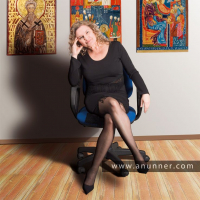 I met the Italian-Armenian Marina Mavian for the first time last August in Venice at a party attended by participants of the intensive summer course in Armenian language and culture organized by the Padus-Araxes Cultural Association. The erstwhile dancer Marina, who now devotes herself to painting, had come to meet me in response to the letter I had sent her in connection with my study on Armenians in the field of dance. She had also wanted to give her children, young Stephanie and Nicola Pambakian, one more opportunity to be in an Armenian environment. I noticed that although Marina was speaking Italian with her children, her conversation was constantly peppered with the Armenian word “hokis” (my dear). We made an appointment for the interview the following day on the island of Lido, Marina’s summer home. Marina Mavian was born in Venice but currently she lives in Milan. Having resided in a small dormitory room in Venice, which was lacking in flora, I found it unusual yet pleasant to be in a domestic environment, to sit in an airy room decorated with antique furniture and fine paintings, and from whose window a blue canal and subtropical vegetation were visible. In the room, one’s attention is drawn to Marina’s unfinished work – a painting of bird letters of the Armenian alphabet. The facial features, the light hair and skin of this attractive lady of this house, who lives between Venice and Milan, where she manages the Armenian House (Hay Doon), give her a totally European appearance, despite her being only one-quarter Italian. Moreover, her light movements betray the fact that she used to be a first-class ballet dancer.
I met the Italian-Armenian Marina Mavian for the first time last August in Venice at a party attended by participants of the intensive summer course in Armenian language and culture organized by the Padus-Araxes Cultural Association. The erstwhile dancer Marina, who now devotes herself to painting, had come to meet me in response to the letter I had sent her in connection with my study on Armenians in the field of dance. She had also wanted to give her children, young Stephanie and Nicola Pambakian, one more opportunity to be in an Armenian environment. I noticed that although Marina was speaking Italian with her children, her conversation was constantly peppered with the Armenian word “hokis” (my dear). We made an appointment for the interview the following day on the island of Lido, Marina’s summer home. Marina Mavian was born in Venice but currently she lives in Milan. Having resided in a small dormitory room in Venice, which was lacking in flora, I found it unusual yet pleasant to be in a domestic environment, to sit in an airy room decorated with antique furniture and fine paintings, and from whose window a blue canal and subtropical vegetation were visible. In the room, one’s attention is drawn to Marina’s unfinished work – a painting of bird letters of the Armenian alphabet. The facial features, the light hair and skin of this attractive lady of this house, who lives between Venice and Milan, where she manages the Armenian House (Hay Doon), give her a totally European appearance, despite her being only one-quarter Italian. Moreover, her light movements betray the fact that she used to be a first-class ballet dancer.

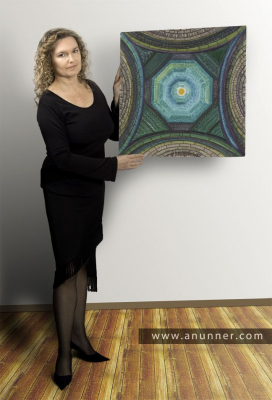
In response to her question about my interest in the art of dance, I told her that it is an old love of mine and proceeded to present her my current, as yet unpublished study called “Armenians in the World of Dance.” Rather, “Armenians in International Dance Scene” I also showed her my computer data bank of photographs I’ve collected of Armenian ballet dancers in various countries of the world.
Marina was pleasantly surprised and said, “I have almost never encountered Armenian surnames in ballet circles.”
Our conversation proceeded in English, with intermittent injections of Italian and Armenian.
“The Mavians are natives of Bursa,” Marina began. “My father Jirair likewise was born in Bursa but moved to Istanbul at the age of four. From there, in turn, the family fled to Bulgaria, to escape new massacres, which a Turkish friend had warned them about. My grandfather lost all his property and possessions but he built a large new house in Burgas. My father attended the Mekhitarist School of Plovdiv and the Mourad-Raphaelian School of Venice; subsequently he studied economics and business in Anvers Belgium. My mother, Augusta Mascarin, was the daughter of a Venetian naval captain and Nevart Ischlemedjian of Izmir. There were three children in our family, with whom Grandma Nevart spoke Armenian as a matter of principle. My grandmother’s parents were saved from the conflagration that swept through Izmir in 1922 and found refuge in Venice with their daughter. Subsequently, my grandmother Nevart accidentally met my future father, then a student, on a train and invited him to her home. That’s how my parents met each other.
One of Marina’s sisters, Linda, works in the cultural affairs office of the province of Veneto; she’s the author of a few collections of poetry in Italian. Rosanna, in turn, is a journalist and steady contributor to a several Italian periodicals.
“I understand Armenian very well,” said Marina, smiling, “although I’m not accustomed to speaking it. My parents used to speak to each other in Armenian but in Italian to their children. I learned Armenian by listening to them. My husband is an Armenian born in Milan and my daughter Stephanie learned Armenian.
The natural beauty of Lido, the presence of the rich Italian and Armenian cultures, and an innate love of art stimulated Marina-Anahid Mavian’s artistic talents from childhood. At the age of 7, she began to attend the Sergey Diaghilev School of Ballet in Venice.
“Watching me perform during my very first lesson, the teacher asked if I had ever danced. I hadn’t previously danced but every movement, every position came to me very easily, as I was a born ballet dancer. Two years later, the director of a famous ballett group with the etoile Carla Fracci came to my school and chose me to participate in a production to be presented in the La Fenice Theater of Venice.
Thus, my professional career began when I was 9 years old, in our truly fantastic La Fenice Theater, whose smells will always remain a part of me. A few years later, another well-known dancer named Roberto Fascilla came from La Scala and, seeing me, said I should continue my education in Milan without fail. The results of my exams were excellent, and I was immediately put in the fourth class, instead of having to go through the three-year preparatory classes. I was already 14 years old, and it was rare for someone of that age, an outsider no less, to be accepted by the La Scala Ballet School. I studied for five years at that distinguished school, which is now a ballet academy. We were taught according to the Cecchetti-Vaganova method. We had an extremely heavy schedule; we practiced 12 hours a day, from 8 a.m. to 8 p.m., and if there was a performance in the evening, we would be tied up until midnight. We didn’t see any daylight on those days. I was only free on Saturday afternoons, and those were spent learning Russian, since my goal was to perfect my technique at Moscow’s Bolshoi Theater. I’m not sorry that it didn’t work out, since I signed a contract with the Deutsche Opera am Rhein, which operates in Dusseldorf and Grand Theatre of Duisburg.

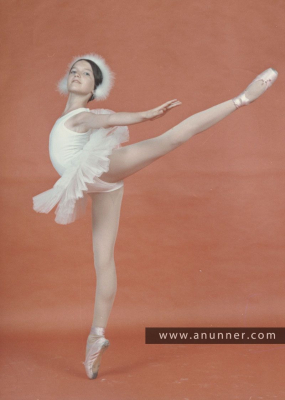
I asked Marina, “Why didn’t you pursue a career at La Scala?” Marina replied, “La Scala is a mighty center of opera but not ballet. In order to be a good ballet dancer, you have to get away from La Scala. If you stay, your efforts will not bear fruit. The administration often changed, which caused great difficulties. Now the ballet school has been removed from the theater, whereas when I was a student there, it was right in La Scala, and you could freely converse with Nureyev or Vasilev, or have a cup of coffee with Paolo Bortolucci. Rehearsals at La Scala would sometimes last a year – with costumes, without costumes, onstage, offstage. Meanwhile, we prepared and gave a performance in one week’s time in Germany. Generally speaking, ballet life in Germany was better organized; first-rate ballet masters were continuously invited. All of us were equal in the group; there was no hierarchy among the performers. Incidentally, I was the only Italian and the only Armenian in the group.”
As a member of the Deutsche Opera am Rhein in the years 1979-1981 Marina Mavian appeared performing various ballets .
“In 1982, I received an invitation to work in Buenos Aires’ Colon Theater. I was glad for that opportunity but then the war over the Falkland Islands broke out, forcing the theater to shut down. In 1986, I got married and left dancing for them,” said Marina, smiling as she pointed to her children. For the first time, the latter were looking attentively at their mother’s ballet photos, which she hadn’t taken out of the family albums for a long time.
Closing the gates on the art of ballet, Marina opened the doors to another magical world – fine art.
“I’ve always painted in my spare time, even when I was a dancer. I concentrated on Armenian spiritual art. I went to Armenia for the first time in 1996. I’ve also been to Western Armenia and seen Aghtamar, Ani….In particular, I’ve been inspired by our wonderful khachkars (cross stones) to devote myself completely to painting. I began to depict monasteries, copy Armenian miniatures, and engage in iconography on wood. I wish to show the public that an important cultural legacy exists in Armenia. This is necessary work, to present ourselves to the world, since extremely little is known about us. Sometimes I am approached after an exhibit and asked, “So the Armenians are Christian, is that so?” Up until now, I’ve had two solo exhibits in Milan and one each in Yerevan and Los Angeles. The Yerevan exhibit took place in August 2006 in the Narekatsi Art Institute, where 50 works of mine, mainly paintings of Armenian monasteries, were on display. I am very inspired by Armenia. It’s true when they say that Armenia is an open-air museum.”

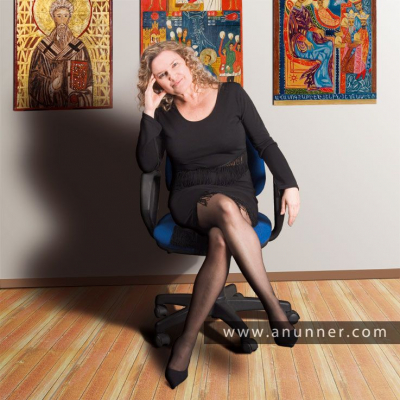
I said, “Isn’t Italy, and Venice in particular, like that too?”
“Venice is a city. But in Armenia you can go to the mountainous region and, along the side of the road, see a little church, an artistic masterpiece, or a khachkar resembling needlework, which is a ready-made museum specimen. Such a thing doesn’t exist in Italy.”
Marina asked about the current political situation in Armenia and expressed anxiety over the war having begun in Georgia. At the end of the conversation, she said:
“Italy loves us. There are some 500 Armenians in Milan and the Lombardy region. I’m now director of the Armenian House in Milan, where, despite insufficient financial means, we periodically hold concerts, lectures, exhibits, film screenings, Armenian language classes and book launchings. I shall continue to paint and I shall endeavor to present and generate interest in our culture, both in Milan and Venice.”
By Artsvi Bakhchinyan
VENICE-YEREVAN.
(Translated by Aris G. Sevag)
• ՀՈԴՎԱԾՆԵՐԸ ՄԱՍՆԱԿԻ ԿԱՄ ԱՄԲՈՂՋՈՒԹՅԱՄԲ ԱՐՏԱՏՊԵԼՈՒ ԿԱՄ ՕԳՏԱԳՈՐԾԵԼՈՒ ԴԵՊՔՈՒՄ ՀՂՈՒՄԸ www.anunner.com ԿԱՅՔԻՆ ՊԱՐՏԱԴԻՐ Է :
• ԵԹԵ ԴՈՒՔ ՈՒՆԵՔ ՍՈՒՅՆ ՀՈԴՎԱԾԸ ԼՐԱՑՆՈՂ ՀԱՎԱՍՏԻ ՏԵՂԵԿՈՒԹՅՈՒՆՆԵՐ ԵՎ
ԼՈՒՍԱՆԿԱՐՆԵՐ,ԽՆԴՐՈՒՄ ԵՆՔ ՈՒՂԱՐԿԵԼ ԴՐԱՆՔ info@anunner.com ԷԼ. ՓՈՍՏԻՆ:
• ԵԹԵ ՆԿԱՏԵԼ ԵՔ ՎՐԻՊԱԿ ԿԱՄ ԱՆՀԱՄԱՊԱՏԱՍԽԱՆՈՒԹՅՈՒՆ, ԽՆԴՐՈՒՄ ԵՆՔ ՏԵՂԵԿԱՑՆԵԼ ՄԵԶ` info@anunner.com:
| Կիսվել : |
 18:13
18:13 Սեպտեմբերի 23-ին Երևանի «Գևորգյան» ցուցասրահում տեղի ունեցավ հայազգի նկարիչ Օնիկ Սահակյանի անհատական ցուցահանդեսը: Սա այն դեպքն է, որի մասին անվերապահորեն կարելի է ասել՝ «անցավ աննախադեպ հաջողությամբ»: Ցուցադրությունը տևեց 15 օր, որի ընթացքում օրական 200-ից ավելի այցելու էր գալիս: Բերված 16 աշխատանքից յոթը վաճառվեցին (14-ը հատուկ նկարվել էր Երևան բերելու համար): Այստեղ մեծ դեր ուներ ոչ միայն պրոֆեսիոնալ գովազդը, այլև այն հանգամանքը, որ Սահակյանը եղել է Սալվադոր Դալիի մտերիմ բարեկամը և օգնականը: ...
Սեպտեմբերի 23-ին Երևանի «Գևորգյան» ցուցասրահում տեղի ունեցավ հայազգի նկարիչ Օնիկ Սահակյանի անհատական ցուցահանդեսը: Սա այն դեպքն է, որի մասին անվերապահորեն կարելի է ասել՝ «անցավ աննախադեպ հաջողությամբ»: Ցուցադրությունը տևեց 15 օր, որի ընթացքում օրական 200-ից ավելի այցելու էր գալիս: Բերված 16 աշխատանքից յոթը վաճառվեցին (14-ը հատուկ նկարվել էր Երևան բերելու համար): Այստեղ մեծ դեր ուներ ոչ միայն պրոֆեսիոնալ գովազդը, այլև այն հանգամանքը, որ Սահակյանը եղել է Սալվադոր Դալիի մտերիմ բարեկամը և օգնականը: ...
 18:10
18:10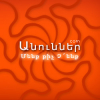 1900 թվականին Ֆլորենցիայի եւ Փարիզի երկու հրատարակչություն լույս են ընծայել ֆրանսերեն մի գիրք՝ «Տեսություն (սոցիալական հետազոտություն)» («Considռrations (Etudes sociales)») վերնագրով, որի հեղինակը հանդես էր եկել Արմենա ծածկանվամբ: Գիրքը, որ վերաբերում էր հայկական հարցին և այդ խնդրի շուրջ եվրոպական դիվանագիտության դիրքորոշմանը, լայն արձագանք է ունեցել եվրոպացի մասնագետների շրջանում: Հեղինակին անվանել են «վեհանձն և բորբոքյալ հոգի», «հանրագիտակ»: Ֆրանսիացի քաղաքական գործիչ Ժան Ժորեսն այդ գիրքը համա...
1900 թվականին Ֆլորենցիայի եւ Փարիզի երկու հրատարակչություն լույս են ընծայել ֆրանսերեն մի գիրք՝ «Տեսություն (սոցիալական հետազոտություն)» («Considռrations (Etudes sociales)») վերնագրով, որի հեղինակը հանդես էր եկել Արմենա ծածկանվամբ: Գիրքը, որ վերաբերում էր հայկական հարցին և այդ խնդրի շուրջ եվրոպական դիվանագիտության դիրքորոշմանը, լայն արձագանք է ունեցել եվրոպացի մասնագետների շրջանում: Հեղինակին անվանել են «վեհանձն և բորբոքյալ հոգի», «հանրագիտակ»: Ֆրանսիացի քաղաքական գործիչ Ժան Ժորեսն այդ գիրքը համա...
 18:07
18:07 Երևանյան դերասանների ընտանիքում Մնջախաղի պետական թատրոնի դերասանուհի Ռուզան Հակոբյանը էականորեն տարբերվում է իր գործընկերուհիներից։ Ոչ միայն իր տարաշխարհիկ, ոչ ստանդարտ արտաքինով։ Թվում է, թե մեր դերասանուհիներից ուրիշ ոչ մեկի խաղն այնքան ենթարկված չէ պլաստիկային, որքան նրանը։ Թվում է, թե իր մարմնի շարժումներով և արտահայտիչ դիմախաղով նա ի զորու է մարմնավորել ամեն մի երևույթ։ Պլաստիկայի լեզվով կերպարի ոչ միայն արտաքինը, այլև ներքինը պատկերելու նրա ձիրքն անուրանալի է։ Երբ որ Ռուզան Հակոբյանը մարմն...
Երևանյան դերասանների ընտանիքում Մնջախաղի պետական թատրոնի դերասանուհի Ռուզան Հակոբյանը էականորեն տարբերվում է իր գործընկերուհիներից։ Ոչ միայն իր տարաշխարհիկ, ոչ ստանդարտ արտաքինով։ Թվում է, թե մեր դերասանուհիներից ուրիշ ոչ մեկի խաղն այնքան ենթարկված չէ պլաստիկային, որքան նրանը։ Թվում է, թե իր մարմնի շարժումներով և արտահայտիչ դիմախաղով նա ի զորու է մարմնավորել ամեն մի երևույթ։ Պլաստիկայի լեզվով կերպարի ոչ միայն արտաքինը, այլև ներքինը պատկերելու նրա ձիրքն անուրանալի է։ Երբ որ Ռուզան Հակոբյանը մարմն...
 17:57
17:57 Համաշխարհային թատրոնի պատմությունն ուսումնասիրելիս նկատելի է մի ուշագրավ իրողություն. 19-րդ դարի վերջին, 20-րդ դարի սկզբին մի շարք հայորդիների վիճակվել է դառնալ այս կամ այն ժողովրդի թատերական գործի ռահվիրա։ Թուրքական պրոֆեսիոնալ թատրոնի հիմնադիրներ դարձան Հակոբ Վարդովյանը և Մարտիրոս Մնակյանը, Իրանում եվրոպական տիպի առաջին ներկայացումը բեմադրեց Արմեն Օհանյանը, վրացական նոր թատրոնի հիմնադիրներից է Միխայիլ Թումանովը, ռուսական էստրադային թատրոնի հիմքը դրեց Նիկիտա Բալիևը, Մոսկվայի հրեական թատրոնինը՝ ...
Համաշխարհային թատրոնի պատմությունն ուսումնասիրելիս նկատելի է մի ուշագրավ իրողություն. 19-րդ դարի վերջին, 20-րդ դարի սկզբին մի շարք հայորդիների վիճակվել է դառնալ այս կամ այն ժողովրդի թատերական գործի ռահվիրա։ Թուրքական պրոֆեսիոնալ թատրոնի հիմնադիրներ դարձան Հակոբ Վարդովյանը և Մարտիրոս Մնակյանը, Իրանում եվրոպական տիպի առաջին ներկայացումը բեմադրեց Արմեն Օհանյանը, վրացական նոր թատրոնի հիմնադիրներից է Միխայիլ Թումանովը, ռուսական էստրադային թատրոնի հիմքը դրեց Նիկիտա Բալիևը, Մոսկվայի հրեական թատրոնինը՝ ...
 17:49
17:49 2007թ-ին Լոնդոնում լույս տեսավ Ֆրանսիայում, Անգլիայում և Ավստրալիայում աշխատած բալետի պարուհի Թամարա Չինարովա Ֆինչի «Պարելով դեպի անհայտը. իմ կյանքը «Բալե Ռյուսում» և նրանից հետո» հուշագիրքը։ Այս պարուհին չի հասել համաշխարհային ճանաչման, սակայն ապրել է հարուստ և հետաքրքրական կյանքով։ Իննսունամյակի շեմին գտնվող նախկին արվեստագիտուհու այդ չափազանց հետաքրքրական հատորն ընթերցելուց հետո նամակով կապվեցինք այսօր Իսպանիայում դստեր հետ ապրող Չինարովայի հետ. վերջինս հաճույքով թույլատրեց թարգմանել իր գր...
2007թ-ին Լոնդոնում լույս տեսավ Ֆրանսիայում, Անգլիայում և Ավստրալիայում աշխատած բալետի պարուհի Թամարա Չինարովա Ֆինչի «Պարելով դեպի անհայտը. իմ կյանքը «Բալե Ռյուսում» և նրանից հետո» հուշագիրքը։ Այս պարուհին չի հասել համաշխարհային ճանաչման, սակայն ապրել է հարուստ և հետաքրքրական կյանքով։ Իննսունամյակի շեմին գտնվող նախկին արվեստագիտուհու այդ չափազանց հետաքրքրական հատորն ընթերցելուց հետո նամակով կապվեցինք այսօր Իսպանիայում դստեր հետ ապրող Չինարովայի հետ. վերջինս հաճույքով թույլատրեց թարգմանել իր գր...













 Arian AMU
Arian AMU
